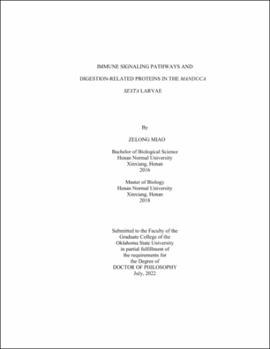| dc.contributor.advisor | Jiang, Haobo | |
| dc.contributor.author | Miao, Zelong | |
| dc.date.accessioned | 2023-04-05T16:21:06Z | |
| dc.date.available | 2023-04-05T16:21:06Z | |
| dc.date.issued | 2022-07 | |
| dc.identifier.uri | https://hdl.handle.net/11244/337302 | |
| dc.description.abstract | M. sexta has been used as a biochemistry model to study insect immunity. While it is unclear how immune genes are specifically regulated by Toll or Imd pathway. We produced the recombinant Spätzle-1 and -2 precursors, activated them using prophenoloxidase activating protease-3 (PAP3), and separately injected them into hemocoel to trigger specific up-regulation of genes controlled by the Toll pathway. M. sexta cell line was treated with E. coli DAP-PG to specifically induce the Imd pathway. RNA-seq analysis of fat body tissues and cell samples indicated that diapausins and lebocins are predominantly regulated via Toll signaling, gallerimycin, X-tox and its splicing variants are synthesized in response to DAP-PG through Imd pathway, whereas attacins, cecropins, moricins, defensins, gloverin, lysozymes, transferrins, and WAPs are induced via both. Furthermore, we separately injected Enterococcus faecalis or Enterobacter cloacae into hemocoel, it showed that most antimicrobial peptides could be induced by both bacteria, such as lebocinD, which is a Toll-specific gene. However, diapausin1, gloverin and cecropin6 were more sensitive to Enterococcus faecalis, X-toxs was more sensitive to Enterobacter cloacae. Our results showed the injection of bacteria cannot separate Toll or Imd pathways properly in M. sexta, which is very different from D. melanogaster. Thus, it confirms the complexity of host-pathogen interactions and innate immune response pathways in other non-dipteran insects. | |
| dc.description.abstract | Food digestion is vital for the survival and prosperity of insects. While digestive enzymes from pest species lacks a systematic analysis. In the genome of Manduca sexta, we identified 122 digestive enzymes including 85 proteases, 20 esterases, 16 carbohydrases, and 1 nuclease. We also further categorized 144 M. sexta serine esterases (SEs) and their homologs, 26 phospholipases and 13 thioesterases. Expression profiling of these genes in specific tissues and stages has provided insights into their functions including digestion, detoxification, hormone processing, neurotransmission, reproduction, and developmental regulation. In summary, these studies provide for the first time a holistic view of the digestion and SE-related proteins in a model lepidopteran insect and clues for comparative research in lepidopteran pests and beyond. | |
| dc.format | application/pdf | |
| dc.language | en_US | |
| dc.rights | Copyright is held by the author who has granted the Oklahoma State University Library the non-exclusive right to share this material in its institutional repository. Contact Digital Library Services at lib-dls@okstate.edu or 405-744-9161 for the permission policy on the use, reproduction or distribution of this material. | |
| dc.title | Immune signaling pathways and digestion-related proteins in the Manduca sexta larvae | |
| dc.contributor.committeeMember | Marek, Stephen M. | |
| dc.contributor.committeeMember | Noden, Bruce H. | |
| dc.contributor.committeeMember | Deng, Junpeng | |
| osu.filename | Miao_okstate_0664D_17805.pdf | |
| osu.accesstype | Open Access | |
| dc.type.genre | Dissertation | |
| dc.type.material | Text | |
| dc.subject.keywords | digestion | |
| dc.subject.keywords | IMD | |
| dc.subject.keywords | serine esterase | |
| dc.subject.keywords | signaling pathways | |
| dc.subject.keywords | toll | |
| thesis.degree.discipline | Entomology | |
| thesis.degree.grantor | Oklahoma State University | |
